Plant trees in kerkini lake
Download as ppt, pdf0 likes307 views
Greece. Visit to Kerkini Lake
1 of 20
Download to read offline



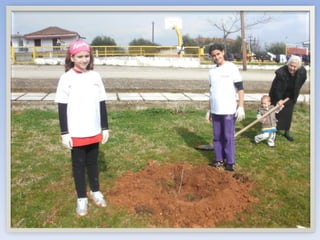

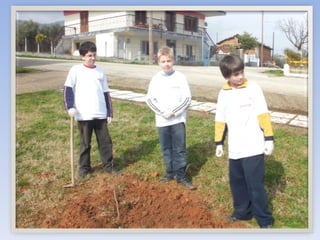

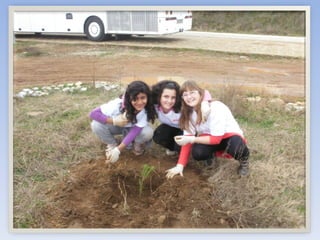


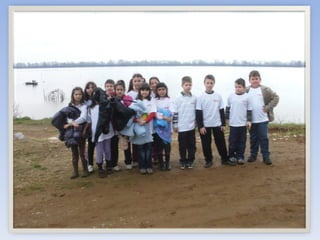
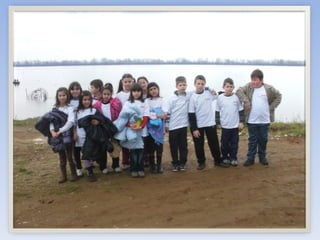
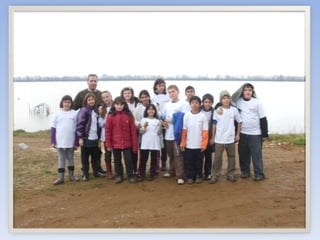

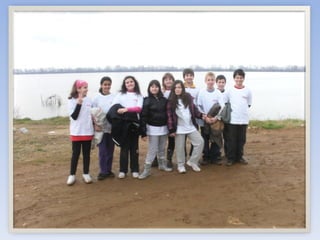
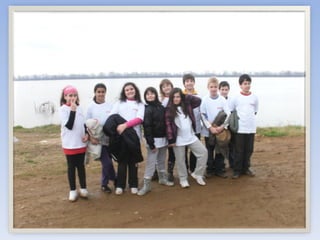



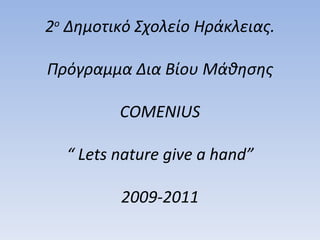
Ad
Recommended
Presentetion Of Greece
Presentetion Of Greecefranciscormm
╠²
Greece occupies the southern end of the Balkan Peninsula in southeastern Europe. It borders Albania, North Macedonia, Bulgaria, and Turkey, and has a population of over 10 million people who are mostly Greek Orthodox. The education system is compulsory between ages 6-15 and includes primary and lower secondary school, with options for vocational training or university afterward. Natural resources include iron, bauxite, and lignite coal. Major industries include agriculture, food/wine, tourism, and manufacturing.MapReduce and Its Discontents
MapReduce and Its DiscontentsDean Wampler
╠²
The document discusses the evolution and future of data processing technologies, particularly the transition from traditional SQL databases to big data architectures that manage large, rapidly changing data sets. It highlights the importance of data-driven programming and machine learning, and presents an overview of the MapReduce framework, particularly in the context of Hadoop, as a solution for processing vast amounts of data efficiently. Key trends in big data, such as increasing data volumes and the shift away from formal schemas, are also emphasized.Comeniuspresfranciscormm
╠²
El documento describe la localidad de Encinarejo, ubicada a 14 km de C├│rdoba, Espa├▒a, a orillas del r├Ło Guadalquivir. Encinarejo tiene una econom├Ła basada hist├│ricamente en la agricultura, cultivando naranjas, ma├Łz y algod├│n. Tambi├®n destaca por el cuidado de sus calles y plazas, habiendo ganado premios. El documento luego describe la escuela primaria del pueblo, que ha crecido de 9 aulas y 172 estudiantes a 25 maestros y 313 estudiantes, con nuevas instalaciones comoMEDLINE search skill retention
MEDLINE search skill retentionjustmelissa
╠²
This study measured the retention of MEDLINE searching skills in medical students from their first to fourth years of medical school under a curriculum-integrated instruction model. 102 fourth-year students completed the same MEDLINE search assignment they had in their first year. Scores were compared using t-tests, correlations, and measures of recall, precision, and F-measure. While mean grades did not significantly change, search output quality as measured by recall, precision and F-measure significantly declined. This suggests students retained the search process but their ability to produce high-quality results decreased over time, calling into question what is being effectively taught and assessed.Let┬┤s Give Nature a Hand Questionnairefranciscormm
╠²
El documento presenta los resultados de una encuesta sobre un proyecto Comenius llamado "Dale una mano a la naturaleza" que involucr├│ a escuelas de Grecia, Italia, Letonia, Portugal, Espa├▒a y Gales. La mayor├Ła de los estudiantes indicaron que el tema principal del proyecto fue la naturaleza y que les gustaron actividades como visitas ecol├│gicas, obras de teatro y siembra de plantas. La mayor├Ła tambi├®n opin├│ que el proyecto fue beneficioso para su escuela y les gustar├Ła participar en otro proyectoCalendario
Calendariofranciscormm
╠²
This document contains calendar pages for each month of the year with days of the week and dates listed in various languages. It also includes illustrations of different animals such as marbled ducks, griffon vultures, and loggerhead sea turtles.Virtual Assistants in the Enterprise
Virtual Assistants in the EnterpriseVinay Dwivedi
╠²
The document discusses the challenges of using enterprise software and how many systems fail to deliver value due to complicated interfaces and stale data. It highlights the potential of voice-powered virtual assistants, like Oracle Voice and Amazon Alexa, to improve access to critical information and enhance productivity in sales teams. The Sapho platform is presented as a solution to consolidate notifications and actions from various business systems, enabling employees to receive timely information and complete tasks efficiently.Ppt Italian
Ppt Italianfranciscormm
╠²
This document provides information about the Luigi Capuana primary school in Palermo, Italy. It describes the structure of primary education in Italy and the subjects taught. It then gives details about the school, including its buildings and facilities, number of students and teachers, and leadership roles. It concludes by listing the partner schools for a Comenius project on giving nature a hand.Reactive Streams 1.0 and Akka Streams
Reactive Streams 1.0 and Akka StreamsDean Wampler
╠²
The document discusses Konrad Malawski's talk on reactive streams at GeeCON 2014 in Krakow, Poland. It introduces reactive streams and their goals of standardized, back-pressured asynchronous stream processing. Reactive streams allow different implementations like RxJava, Reactor, Akka Streams, and Vert.x to interoperate using a common protocol. The document provides an example of integrating RxJava, Akka Streams, and Reactor streams to demonstrate this interoperability. It also discusses concepts like back pressure to prevent buffer overflows when processing streams.Why Spark Is the Next Top (Compute) Model
Why Spark Is the Next Top (Compute) ModelDean Wampler
╠²
This document provides an overview of Spark and why it is considered the next top compute model. It begins by discussing some limitations of Hadoop and MapReduce, such as the restrictive two-step compute model (map and reduce only), lack of flexibility that inhibits optimizations, and dumping of intermediate data to disk between jobs. It then introduces Spark, highlighting features like its more flexible compute model using RDDs that support intelligent caching, ability to run on Hadoop, Mesos and standalone, and APIs in Scala, Java, Python and R. It provides an example of implementing an inverted index in MapReduce versus Spark to demonstrate Spark's advantages.Error Handling in Reactive Systems
Error Handling in Reactive SystemsDean Wampler
╠²
The document discusses error handling in reactive systems, emphasizing that failures must be considered first-class citizens due to their inevitability in large systems. It covers various strategies, including combining functional programming with reactive approaches, using communicating sequential processes (CSP), and leveraging types to prevent errors. Additionally, it highlights the importance of handling failures in both CSP and reactive extensions, while maintaining a need for a broader strategy for reactive resiliency at scale.Proyecto escolar huerto ecologicofranciscormm
╠²
Este documento describe un proyecto educativo para crear un huerto ecol├│gico en el que se cultivan frutas y hortalizas sin usar pesticidas da├▒inos. Explica qu├® es un huerto ecol├│gico y los pesticidas convencionales que se evitan, y resume las etapas de preparaci├│n del terreno, la construcci├│n de un invernadero, y la siembra en semilleros para cultivar los productos de forma sostenible.Spark the next top compute model
Spark the next top compute modelDean Wampler
╠²
The document discusses the limitations of the Hadoop MapReduce model for big data processing and introduces Apache Spark as a more efficient alternative. Spark provides a flexible compute model with resilient distributed datasets (RDDs) that enable faster job execution through in-memory data caching, avoiding the bottleneck of frequent disk flushes inherent in MapReduce. The document illustrates how Spark simplifies the implementation of complex algorithms compared to Hadoop, using the example of creating an inverted index.Reactive design: languages, and paradigms
Reactive design: languages, and paradigmsDean Wampler
╠²
The document presents a critique of object-oriented programming (OOP) in the context of reactive programming, emphasizing that while OOP has its merits, it often complicates scalability, responsiveness, and resilience in high-performance applications. It advocates for minimizing code bloat, utilizing immutable structures, and leveraging functional programming principles to enhance system performance. Additionally, the author suggests that domain-driven design should focus on understanding the domain without necessitating a heavy implementation in code, to avoid pitfalls associated with OOP.Why Spark Is the Next Top (Compute) Model
Why Spark Is the Next Top (Compute) ModelDean Wampler
╠²
This document contains code for implementing an inverted index using Apache Hadoop MapReduce. The code includes a main class that sets up the job, a LineIndexMapper class containing the map method to tokenize text and output (word, document) pairs, and a LineIndexReducer class containing the reduce method to aggregate values for each word key into a comma-separated string. The code implements the basic MapReduce pattern of mapping input data to intermediate key-value pairs, shuffling, and reducing to output the final index.Why Scala Is Taking Over the Big Data World
Why Scala Is Taking Over the Big Data WorldDean Wampler
╠²
The document discusses how Scala is becoming increasingly popular for big data applications. It provides context about the evolution of Hadoop and MapReduce as the main computing framework for big data in 2008. It notes that implementing algorithms with just MapReduce steps was difficult, and that the Hadoop API was low-level and tedious to work with. Scala is taking over as it allows for more complex algorithms to be implemented more easily compared to the MapReduce model and Hadoop's API.Our school, our village!!!franciscormm
╠²
Encinarajo es un pueblo ubicado a 14 km de C├│rdoba, junto al r├Ło Guadalquivir, con una econom├Ła basada en la agricultura, destacando cultivos como naranjas, ma├Łz y algod├│n. El pueblo es conocido por la belleza de sus calles y plazas, y su colegio ha crecido significativamente, pasando de 172 alumnos y 14 profesores a 313 alumnos y 25 profesores. Actualmente, el colegio ense├▒a diversas materias utilizando nuevas tecnolog├Łas y organiza un d├Ła escolar que incluye tiempo para aprender y jugar.Evoluci├│n humana pptfranciscormm
╠²
El documento detalla la evoluci├│n humana desde los primeros hom├Łnidos en ├üfrica, destacando el proceso de hominizaci├│n que comenz├│ hace 6,5 millones de a├▒os, caracterizado por cambios anat├│micos, ps├Łquicos y culturales. Se presentan diversos g├®neros de hom├Łnidos, como Australopithecus y Homo, junto con sus caracter├Łsticas, evoluci├│n del tama├▒o cerebral y el uso de herramientas, culminando en el Homo sapiens. Adem├Īs, se menciona la interacci├│n gen├®tica entre neandertales y Homo sapiens, subrayando la complejidad de la evoluci├│n humana.Para pdffranciscormm
╠²
Este documento contiene un calendario mensual en varios idiomas, incluyendo los nombres de los meses en ingl├®s, espa├▒ol, griego, let├│n y otros idiomas, as├Ł como los d├Łas de la semana tambi├®n en varios idiomas. Adem├Īs, incluye la informaci├│n de nombre, edad y escuela de un estudiante.Ppt de las abejasfranciscormm
╠²
Este documento resume los principales tipos y caracter├Łsticas de las abejas. Describe las tres castas principales de abejas de la miel (reina, z├Īngano y obrera) y sus tareas. Tambi├®n cubre los enemigos comunes de las abejas como la varroa destructor, y resume brevemente la historia de la apicultura desde la antig├╝edad hasta la apicultura contempor├Īnea.Ppt de las abejasfranciscormm
╠²
Este documento resume los principales tipos y caracter├Łsticas de las abejas. Describe las tres castas principales de abejas de la miel (reina, z├Īngano y obrera) y sus tareas. Tambi├®n cubre los enemigos comunes de las abejas como la varroa destructor, y resume la historia de la apicultura desde la recolecci├│n silvestre hasta la apicultura contempor├Īnea con cuadros m├│viles.Presentaci├│n calendario 2010
Presentaci├│n calendario 2010franciscormm
╠²
This document lists the 12 months of the year in order from January to December. It provides a simple listing of the months without additional details or descriptions. The months are presented in their typical order from the beginning to the end of the calendar year.Presentaci├│n calendarios
Presentaci├│n calendariosfranciscormm
╠²
This document lists the 12 months of the year in order from January to December. It provides a simple listing of the months without additional details or descriptions. The months are presented in their typical order from the beginning to the end of the calendar year.Presentaci├│n calendarios
Presentaci├│n calendariosfranciscormm
╠²
This document lists the twelve months of the year in order from January through December. It provides a simple chronological listing of the months without additional details about each month. The document serves as a brief reference of the standard calendar year.Philippine Independence Day 2025- Programma.pdf
Philippine Independence Day 2025- Programma.pdfTassos Karampinis
╠²
Philippine Independence Day 2025- Programma.pdf
Araw ng Kalayaan ng Pilipinas 2025
╬ÜŽģŽü╬╣╬▒╬║╬«, 8 ╬Ö╬┐Žģ╬Į╬»╬┐Žģ 2025
╬żŽāŽīŽć╬▒ ╬║╬▒╬╣ ╬£╬Ą╬╗╬¼
56╬┐ ╬ōŽģ╬╝╬Į╬¼Žā╬╣╬┐ ╬æ╬Ė╬«╬Į╬▒ŽéKeimenoTelikhsGiortis-V1.pdf╬ŻŽć╬┐╬╗╬╣╬║Žī ╬ŁŽä╬┐Žé: 2024-2025
KeimenoTelikhsGiortis-V1.pdf╬ŻŽć╬┐╬╗╬╣╬║Žī ╬ŁŽä╬┐Žé: 2024-2025Tassos Karampinis
╠²
KeimenoTelikhsGiortis-V1.pdf
56o ╬ōŽģ╬╝╬Į╬¼Žā╬╣╬┐ ╬æ╬Ė╬«╬Į╬▒Žé
╬ŻŽć╬┐╬╗╬╣╬║Žī ╬ŁŽä╬┐Žé: 2024-2025╬æŽĆ╬┐Žć╬▒╬╣Žü╬ĄŽä╬╣ŽāŽä╬«Žü╬╣╬▒ ╬│╬╣╬┐ŽüŽä╬« ╬Ż╬ż╬ä Žä╬¼╬Š╬Ę - ╬ŻŽć╬┐╬╗╬╣╬║Žī ╬łŽä╬┐Žé 2024 - 2025.Žé.pptx
╬æŽĆ╬┐Žć╬▒╬╣Žü╬ĄŽä╬╣ŽāŽä╬«Žü╬╣╬▒ ╬│╬╣╬┐ŽüŽä╬« ╬Ż╬ż╬ä Žä╬¼╬Š╬Ę - ╬ŻŽć╬┐╬╗╬╣╬║Žī ╬łŽä╬┐Žé 2024 - 2025.Žé.pptx36dimperist
╠²
╬æŽĆŽī Žä╬Ę╬Į ╬▒ŽĆ╬┐Žć╬▒╬╣Žü╬ĄŽä╬╣ŽāŽä╬«Žü╬╣╬▒ ╬Ą╬║╬┤╬«╬╗ŽēŽā╬Ę ŽäŽē╬Į ╬╝╬▒╬Ė╬ĘŽäŽÄ╬Į Žä╬ĘŽé ╬Ż╬ż╬ä Žä╬¼╬Š╬ĘŽé Žä╬┐Žģ ŽāŽć╬┐╬╗╬Ą╬»╬┐Žģ ╬╝╬▒Žé. ╬ōŽģ╬╝╬Į╬¼Žā╬╣╬┐, ╬ĄŽüŽćŽī╬╝╬▒ŽāŽä╬Ą!!! TelikiParousiasiPerivallontiko.pdf56o ╬ōŽģ╬╝╬Į╬¼Žā╬╣╬┐ ╬æ╬Ė╬«╬Į╬▒Žé
TelikiParousiasiPerivallontiko.pdf56o ╬ōŽģ╬╝╬Į╬¼Žā╬╣╬┐ ╬æ╬Ė╬«╬Į╬▒ŽéTassos Karampinis
╠²
TelikiParousiasiPerivallontiko.pdf
56o ╬ōŽģ╬╝╬Į╬¼Žā╬╣╬┐ ╬æ╬Ė╬«╬Į╬▒Žé
╬ŻŽć╬┐╬╗╬╣╬║Žī ╬ŁŽä╬┐Žé: 2024-2025TelikiParousiasiSintaktikisFotografikisOEP.pdf
TelikiParousiasiSintaktikisFotografikisOEP.pdfTassos Karampinis
╠²
TelikiParousiasiSintaktikisFotografikisOEP.pdf
56o ╬ōŽģ╬╝╬Į╬¼Žā╬╣╬┐ ╬æ╬Ė╬«╬Į╬▒Žé
╬ŻŽć╬┐╬╗╬╣╬║Žī ╬ŁŽä╬┐Žé: 2024-2025Erasmus_Job_Shadowing_Full_Final_Presentation.pptx
Erasmus_Job_Shadowing_Full_Final_Presentation.pptxcnenou
╠²
Job shadowing in Albacete, erasmus+ accreditationMore Related Content
Viewers also liked (8)
Reactive Streams 1.0 and Akka Streams
Reactive Streams 1.0 and Akka StreamsDean Wampler
╠²
The document discusses Konrad Malawski's talk on reactive streams at GeeCON 2014 in Krakow, Poland. It introduces reactive streams and their goals of standardized, back-pressured asynchronous stream processing. Reactive streams allow different implementations like RxJava, Reactor, Akka Streams, and Vert.x to interoperate using a common protocol. The document provides an example of integrating RxJava, Akka Streams, and Reactor streams to demonstrate this interoperability. It also discusses concepts like back pressure to prevent buffer overflows when processing streams.Why Spark Is the Next Top (Compute) Model
Why Spark Is the Next Top (Compute) ModelDean Wampler
╠²
This document provides an overview of Spark and why it is considered the next top compute model. It begins by discussing some limitations of Hadoop and MapReduce, such as the restrictive two-step compute model (map and reduce only), lack of flexibility that inhibits optimizations, and dumping of intermediate data to disk between jobs. It then introduces Spark, highlighting features like its more flexible compute model using RDDs that support intelligent caching, ability to run on Hadoop, Mesos and standalone, and APIs in Scala, Java, Python and R. It provides an example of implementing an inverted index in MapReduce versus Spark to demonstrate Spark's advantages.Error Handling in Reactive Systems
Error Handling in Reactive SystemsDean Wampler
╠²
The document discusses error handling in reactive systems, emphasizing that failures must be considered first-class citizens due to their inevitability in large systems. It covers various strategies, including combining functional programming with reactive approaches, using communicating sequential processes (CSP), and leveraging types to prevent errors. Additionally, it highlights the importance of handling failures in both CSP and reactive extensions, while maintaining a need for a broader strategy for reactive resiliency at scale.Proyecto escolar huerto ecologicofranciscormm
╠²
Este documento describe un proyecto educativo para crear un huerto ecol├│gico en el que se cultivan frutas y hortalizas sin usar pesticidas da├▒inos. Explica qu├® es un huerto ecol├│gico y los pesticidas convencionales que se evitan, y resume las etapas de preparaci├│n del terreno, la construcci├│n de un invernadero, y la siembra en semilleros para cultivar los productos de forma sostenible.Spark the next top compute model
Spark the next top compute modelDean Wampler
╠²
The document discusses the limitations of the Hadoop MapReduce model for big data processing and introduces Apache Spark as a more efficient alternative. Spark provides a flexible compute model with resilient distributed datasets (RDDs) that enable faster job execution through in-memory data caching, avoiding the bottleneck of frequent disk flushes inherent in MapReduce. The document illustrates how Spark simplifies the implementation of complex algorithms compared to Hadoop, using the example of creating an inverted index.Reactive design: languages, and paradigms
Reactive design: languages, and paradigmsDean Wampler
╠²
The document presents a critique of object-oriented programming (OOP) in the context of reactive programming, emphasizing that while OOP has its merits, it often complicates scalability, responsiveness, and resilience in high-performance applications. It advocates for minimizing code bloat, utilizing immutable structures, and leveraging functional programming principles to enhance system performance. Additionally, the author suggests that domain-driven design should focus on understanding the domain without necessitating a heavy implementation in code, to avoid pitfalls associated with OOP.Why Spark Is the Next Top (Compute) Model
Why Spark Is the Next Top (Compute) ModelDean Wampler
╠²
This document contains code for implementing an inverted index using Apache Hadoop MapReduce. The code includes a main class that sets up the job, a LineIndexMapper class containing the map method to tokenize text and output (word, document) pairs, and a LineIndexReducer class containing the reduce method to aggregate values for each word key into a comma-separated string. The code implements the basic MapReduce pattern of mapping input data to intermediate key-value pairs, shuffling, and reducing to output the final index.Why Scala Is Taking Over the Big Data World
Why Scala Is Taking Over the Big Data WorldDean Wampler
╠²
The document discusses how Scala is becoming increasingly popular for big data applications. It provides context about the evolution of Hadoop and MapReduce as the main computing framework for big data in 2008. It notes that implementing algorithms with just MapReduce steps was difficult, and that the Hadoop API was low-level and tedious to work with. Scala is taking over as it allows for more complex algorithms to be implemented more easily compared to the MapReduce model and Hadoop's API.More from franciscormm (8)
Our school, our village!!!franciscormm
╠²
Encinarajo es un pueblo ubicado a 14 km de C├│rdoba, junto al r├Ło Guadalquivir, con una econom├Ła basada en la agricultura, destacando cultivos como naranjas, ma├Łz y algod├│n. El pueblo es conocido por la belleza de sus calles y plazas, y su colegio ha crecido significativamente, pasando de 172 alumnos y 14 profesores a 313 alumnos y 25 profesores. Actualmente, el colegio ense├▒a diversas materias utilizando nuevas tecnolog├Łas y organiza un d├Ła escolar que incluye tiempo para aprender y jugar.Evoluci├│n humana pptfranciscormm
╠²
El documento detalla la evoluci├│n humana desde los primeros hom├Łnidos en ├üfrica, destacando el proceso de hominizaci├│n que comenz├│ hace 6,5 millones de a├▒os, caracterizado por cambios anat├│micos, ps├Łquicos y culturales. Se presentan diversos g├®neros de hom├Łnidos, como Australopithecus y Homo, junto con sus caracter├Łsticas, evoluci├│n del tama├▒o cerebral y el uso de herramientas, culminando en el Homo sapiens. Adem├Īs, se menciona la interacci├│n gen├®tica entre neandertales y Homo sapiens, subrayando la complejidad de la evoluci├│n humana.Para pdffranciscormm
╠²
Este documento contiene un calendario mensual en varios idiomas, incluyendo los nombres de los meses en ingl├®s, espa├▒ol, griego, let├│n y otros idiomas, as├Ł como los d├Łas de la semana tambi├®n en varios idiomas. Adem├Īs, incluye la informaci├│n de nombre, edad y escuela de un estudiante.Ppt de las abejasfranciscormm
╠²
Este documento resume los principales tipos y caracter├Łsticas de las abejas. Describe las tres castas principales de abejas de la miel (reina, z├Īngano y obrera) y sus tareas. Tambi├®n cubre los enemigos comunes de las abejas como la varroa destructor, y resume brevemente la historia de la apicultura desde la antig├╝edad hasta la apicultura contempor├Īnea.Ppt de las abejasfranciscormm
╠²
Este documento resume los principales tipos y caracter├Łsticas de las abejas. Describe las tres castas principales de abejas de la miel (reina, z├Īngano y obrera) y sus tareas. Tambi├®n cubre los enemigos comunes de las abejas como la varroa destructor, y resume la historia de la apicultura desde la recolecci├│n silvestre hasta la apicultura contempor├Īnea con cuadros m├│viles.Presentaci├│n calendario 2010
Presentaci├│n calendario 2010franciscormm
╠²
This document lists the 12 months of the year in order from January to December. It provides a simple listing of the months without additional details or descriptions. The months are presented in their typical order from the beginning to the end of the calendar year.Presentaci├│n calendarios
Presentaci├│n calendariosfranciscormm
╠²
This document lists the 12 months of the year in order from January to December. It provides a simple listing of the months without additional details or descriptions. The months are presented in their typical order from the beginning to the end of the calendar year.Presentaci├│n calendarios
Presentaci├│n calendariosfranciscormm
╠²
This document lists the twelve months of the year in order from January through December. It provides a simple chronological listing of the months without additional details about each month. The document serves as a brief reference of the standard calendar year.Ad
Recently uploaded (14)
Philippine Independence Day 2025- Programma.pdf
Philippine Independence Day 2025- Programma.pdfTassos Karampinis
╠²
Philippine Independence Day 2025- Programma.pdf
Araw ng Kalayaan ng Pilipinas 2025
╬ÜŽģŽü╬╣╬▒╬║╬«, 8 ╬Ö╬┐Žģ╬Į╬»╬┐Žģ 2025
╬żŽāŽīŽć╬▒ ╬║╬▒╬╣ ╬£╬Ą╬╗╬¼
56╬┐ ╬ōŽģ╬╝╬Į╬¼Žā╬╣╬┐ ╬æ╬Ė╬«╬Į╬▒ŽéKeimenoTelikhsGiortis-V1.pdf╬ŻŽć╬┐╬╗╬╣╬║Žī ╬ŁŽä╬┐Žé: 2024-2025
KeimenoTelikhsGiortis-V1.pdf╬ŻŽć╬┐╬╗╬╣╬║Žī ╬ŁŽä╬┐Žé: 2024-2025Tassos Karampinis
╠²
KeimenoTelikhsGiortis-V1.pdf
56o ╬ōŽģ╬╝╬Į╬¼Žā╬╣╬┐ ╬æ╬Ė╬«╬Į╬▒Žé
╬ŻŽć╬┐╬╗╬╣╬║Žī ╬ŁŽä╬┐Žé: 2024-2025╬æŽĆ╬┐Žć╬▒╬╣Žü╬ĄŽä╬╣ŽāŽä╬«Žü╬╣╬▒ ╬│╬╣╬┐ŽüŽä╬« ╬Ż╬ż╬ä Žä╬¼╬Š╬Ę - ╬ŻŽć╬┐╬╗╬╣╬║Žī ╬łŽä╬┐Žé 2024 - 2025.Žé.pptx
╬æŽĆ╬┐Žć╬▒╬╣Žü╬ĄŽä╬╣ŽāŽä╬«Žü╬╣╬▒ ╬│╬╣╬┐ŽüŽä╬« ╬Ż╬ż╬ä Žä╬¼╬Š╬Ę - ╬ŻŽć╬┐╬╗╬╣╬║Žī ╬łŽä╬┐Žé 2024 - 2025.Žé.pptx36dimperist
╠²
╬æŽĆŽī Žä╬Ę╬Į ╬▒ŽĆ╬┐Žć╬▒╬╣Žü╬ĄŽä╬╣ŽāŽä╬«Žü╬╣╬▒ ╬Ą╬║╬┤╬«╬╗ŽēŽā╬Ę ŽäŽē╬Į ╬╝╬▒╬Ė╬ĘŽäŽÄ╬Į Žä╬ĘŽé ╬Ż╬ż╬ä Žä╬¼╬Š╬ĘŽé Žä╬┐Žģ ŽāŽć╬┐╬╗╬Ą╬»╬┐Žģ ╬╝╬▒Žé. ╬ōŽģ╬╝╬Į╬¼Žā╬╣╬┐, ╬ĄŽüŽćŽī╬╝╬▒ŽāŽä╬Ą!!! TelikiParousiasiPerivallontiko.pdf56o ╬ōŽģ╬╝╬Į╬¼Žā╬╣╬┐ ╬æ╬Ė╬«╬Į╬▒Žé
TelikiParousiasiPerivallontiko.pdf56o ╬ōŽģ╬╝╬Į╬¼Žā╬╣╬┐ ╬æ╬Ė╬«╬Į╬▒ŽéTassos Karampinis
╠²
TelikiParousiasiPerivallontiko.pdf
56o ╬ōŽģ╬╝╬Į╬¼Žā╬╣╬┐ ╬æ╬Ė╬«╬Į╬▒Žé
╬ŻŽć╬┐╬╗╬╣╬║Žī ╬ŁŽä╬┐Žé: 2024-2025TelikiParousiasiSintaktikisFotografikisOEP.pdf
TelikiParousiasiSintaktikisFotografikisOEP.pdfTassos Karampinis
╠²
TelikiParousiasiSintaktikisFotografikisOEP.pdf
56o ╬ōŽģ╬╝╬Į╬¼Žā╬╣╬┐ ╬æ╬Ė╬«╬Į╬▒Žé
╬ŻŽć╬┐╬╗╬╣╬║Žī ╬ŁŽä╬┐Žé: 2024-2025Erasmus_Job_Shadowing_Full_Final_Presentation.pptx
Erasmus_Job_Shadowing_Full_Final_Presentation.pptxcnenou
╠²
Job shadowing in Albacete, erasmus+ accreditationMarko Batista Temporary Objects And Hybrid Ambients Batista
Marko Batista Temporary Objects And Hybrid Ambients Batistandumuseika
╠²
Marko Batista Temporary Objects And Hybrid Ambients Batista
Marko Batista Temporary Objects And Hybrid Ambients Batista
Marko Batista Temporary Objects And Hybrid Ambients Batista╬ĢŽü╬│╬▒Žā╬»╬ĄŽé ╬¤╬┤ŽŹŽāŽā╬Ą╬╣╬▒Žé, ╬æ2, ╬Ü╬┐Žü╬│╬╣╬▒╬╗╬Ł╬Į╬Ą╬╣╬┐ 1╬┐ ╬ōŽģ╬╝╬Į╬¼Žā╬╣╬┐ ╬æŽü╬│╬┐ŽāŽä╬┐╬╗╬»╬┐Žģ, 2024-25.pptx
╬ĢŽü╬│╬▒Žā╬»╬ĄŽé ╬¤╬┤ŽŹŽāŽā╬Ą╬╣╬▒Žé, ╬æ2, ╬Ü╬┐Žü╬│╬╣╬▒╬╗╬Ł╬Į╬Ą╬╣╬┐ 1╬┐ ╬ōŽģ╬╝╬Į╬¼Žā╬╣╬┐ ╬æŽü╬│╬┐ŽāŽä╬┐╬╗╬»╬┐Žģ, 2024-25.pptxEugenia Kosmatou
╠²
╬¤╬╣ ╬╝╬▒╬Ė╬ĘŽä╬ŁŽé/ŽäŽü╬╣╬ĄŽé ╬ČŽē╬│Žü╬¼Žå╬╣Žā╬▒╬Į ╬║╬▒╬╣ ╬║╬▒Žä╬▒Žā╬║╬ĄŽŹ╬▒Žā╬▒╬Į ŽāŽć╬Ą╬┤╬»╬ĄŽé ŽāŽä╬┐ ╬╝╬¼╬Ė╬Ę╬╝╬▒ Žä╬ĘŽé ╬¤╬┤ŽŹŽāŽā╬Ą╬╣╬▒Žé. ╬ż╬▒ ╬ŁŽü╬│╬▒ Žä╬┐ŽģŽé ╬▒ŽĆ╬┐ŽäŽģŽĆŽÄ╬Į╬┐╬ĮŽä╬▒╬╣ Žā╬Ą ╬▒ŽģŽäŽī Žä╬┐ p.p.╬ö╬╣╬▒ŽäŽü╬┐Žå╬«- ╬ÜŽģ╬║╬╗╬▒╬┤╬╣╬║ŽīŽé ╬Ā╬┐╬╗╬╣Žä╬╣Žā╬╝ŽīŽé- ╬ō' ╬ö╬Ę╬╝╬┐Žä╬╣╬║╬┐ŽŹ.pptx
╬ö╬╣╬▒ŽäŽü╬┐Žå╬«- ╬ÜŽģ╬║╬╗╬▒╬┤╬╣╬║ŽīŽé ╬Ā╬┐╬╗╬╣Žä╬╣Žā╬╝ŽīŽé- ╬ō' ╬ö╬Ę╬╝╬┐Žä╬╣╬║╬┐ŽŹ.pptxssusera01664
╠²
╬ł╬Į╬▒ slidesahare ╬▓╬▒Žā╬╣Žā╬╝╬Ł╬Į╬┐ ŽāŽä╬┐ ŽĆŽüŽÄŽä╬┐ ╬╝╬¼╬Ė╬Ę╬╝╬▒ Žä╬ĘŽé Žī╬│╬┤╬┐╬ĘŽé ╬Ą╬ĮŽīŽä╬ĘŽä╬▒Žé Žä╬ĘŽé ╬ÖŽāŽä╬┐Žü╬»╬▒Žé ╬ō' ╬ö╬Ę╬╝╬┐Žä╬╣╬║╬┐ŽŹ ╬▒╬Į╬▒ŽĆŽī╬╗╬ĘŽā╬Ę ŽäŽē╬Į ╬┤Žü╬▒ŽāŽä╬ĘŽü╬╣╬┐Žä╬«ŽäŽē╬Į Žä╬ĘŽé ╬ĄŽå╬Ę╬╝╬ĄŽü╬»╬┤╬▒Žé ╬╝╬▒Žé
╬▒╬Į╬▒ŽĆŽī╬╗╬ĘŽā╬Ę ŽäŽē╬Į ╬┤Žü╬▒ŽāŽä╬ĘŽü╬╣╬┐Žä╬«ŽäŽē╬Į Žä╬ĘŽé ╬ĄŽå╬Ę╬╝╬ĄŽü╬»╬┤╬▒Žé ╬╝╬▒Žé╬æŽåŽü╬┐╬┤╬»Žä╬Ę ╬ö╬╣╬▒╬╝╬▒╬ĮŽä╬┐ŽĆ╬┐ŽŹ╬╗╬┐Žģ
╠²
╬ī╬╗╬ĄŽé ╬┐╬╣ ╬┤Žü╬¼Žā╬Ą╬╣Žé ŽĆ╬┐Žģ ╬Ł╬│╬╣╬Į╬▒╬Į ŽāŽä╬┐ ŽĆ╬╗╬▒╬»Žā╬╣╬┐ Žä╬ĘŽé ŽāŽć╬┐╬╗╬╣╬║╬«Žé ╬ĄŽå╬Ę╬╝╬ĄŽü╬»╬┤╬▒Žé ╬┐╬╣ "╬Ģ╬Į╬▒╬╗╬╗╬▒╬║Žä╬╣╬║╬┐╬»"╬ĢŽü╬│╬▒Žā╬»╬ĄŽé ╬¤╬┤ŽŹŽāŽā╬Ą╬╣╬▒Žé, ╬æ1, ╬Ü╬┐Žü╬│╬╣╬▒╬╗╬Ł╬Į╬Ą╬╣╬┐ 1╬┐ ╬ōŽģ╬╝╬Į╬¼Žā╬╣╬┐ ╬æŽü╬│╬┐ŽāŽä╬┐╬╗╬»╬┐Žģ, 2024-25.pptx
╬ĢŽü╬│╬▒Žā╬»╬ĄŽé ╬¤╬┤ŽŹŽāŽā╬Ą╬╣╬▒Žé, ╬æ1, ╬Ü╬┐Žü╬│╬╣╬▒╬╗╬Ł╬Į╬Ą╬╣╬┐ 1╬┐ ╬ōŽģ╬╝╬Į╬¼Žā╬╣╬┐ ╬æŽü╬│╬┐ŽāŽä╬┐╬╗╬»╬┐Žģ, 2024-25.pptxEugenia Kosmatou
╠²
╬¤╬╣ ╬╝╬▒╬Ė╬ĘŽä╬ŁŽé/ŽäŽü╬╣╬ĄŽé ╬ČŽē╬│Žü╬¼Žå╬╣Žā╬▒╬Į ╬║╬▒╬╣ ╬║╬▒Žä╬▒Žā╬║╬ĄŽŹ╬▒Žā╬▒╬Į ŽāŽć╬Ą╬┤╬»╬ĄŽé ŽāŽä╬┐ ╬╝╬¼╬Ė╬Ę╬╝╬▒ Žä╬ĘŽé ╬¤╬┤ŽŹŽāŽā╬Ą╬╣╬▒Žé. ╬ż╬▒ ╬ŁŽü╬│╬▒ Žä╬┐ŽģŽé ╬▒ŽĆ╬┐ŽäŽģŽĆŽÄ╬Į╬┐╬ĮŽä╬▒╬╣ Žā╬Ą ╬▒ŽģŽäŽī Žä╬┐ p.p.╬Ś ╬£╬▒╬║╬▒Žü╬┐╬Į╬┐ŽĆ╬┐╬╗╬╣Žä╬Ą╬»╬▒ ŽäŽē╬Į ╬╝╬▒╬Ė╬ĘŽäŽÄ╬Į Žä╬ĘŽé ╬Æ Žä╬¼╬Š╬ĘŽé Žä╬┐Žģ ŽāŽć╬┐╬╗╬Ą╬»╬┐Žģ ╬╝╬▒Žé.pptx
╬Ś ╬£╬▒╬║╬▒Žü╬┐╬Į╬┐ŽĆ╬┐╬╗╬╣Žä╬Ą╬»╬▒ ŽäŽē╬Į ╬╝╬▒╬Ė╬ĘŽäŽÄ╬Į Žä╬ĘŽé ╬Æ Žä╬¼╬Š╬ĘŽé Žä╬┐Žģ ŽāŽć╬┐╬╗╬Ą╬»╬┐Žģ ╬╝╬▒Žé.pptx36dimperist
╠²
╬Ś ╬£╬▒╬║╬▒Žü╬┐╬Į╬┐ŽĆ╬┐╬╗╬╣Žä╬Ą╬»╬▒ ŽäŽē╬Į ╬╝╬▒╬Ė╬ĘŽäŽÄ╬Į Žä╬ĘŽé ╬Æ Žä╬¼╬Š╬ĘŽé Žä╬┐Žģ ŽāŽć╬┐╬╗╬Ą╬»╬┐Žģ ╬╝╬▒Žé╬æŽüŽć╬▒╬╣╠ü╬▒_╬æ_╬ōŽģ╬╝╬Į╬▒Žā╬»╬┐Žģ_╬Ģ╬ĮŽīŽä╬ĘŽä╬▒ 3_╬Ü╬Ą╬»╬╝╬Ą╬Į╬┐-ŽāŽćŽī╬╗╬╣╬▒.pptx
╬æŽüŽć╬▒╬╣╠ü╬▒_╬æ_╬ōŽģ╬╝╬Į╬▒Žā╬»╬┐Žģ_╬Ģ╬ĮŽīŽä╬ĘŽä╬▒ 3_╬Ü╬Ą╬»╬╝╬Ą╬Į╬┐-ŽāŽćŽī╬╗╬╣╬▒.pptxolymleng
╠²
╬æꎎć╬▒╬╣╠ü╬▒│Õ╬ō│Õ╬Ģ╬Į╬┐╠üŽä╬ĘŽä╬▒│Õ╬æ│Õ╬ōŽģ╬╝╬ĢŽü╬│╬▒Žā╬»╬▒ ╬Ż╬ż' Žä╬¼╬Š╬ĘŽé 2024-2025 (╬æŽåŽü╬╣╬║╬Ę2 Iman & ╬ż╬Č╬┐Žé).ppt
╬ĢŽü╬│╬▒Žā╬»╬▒ ╬Ż╬ż' Žä╬¼╬Š╬ĘŽé 2024-2025 (╬æŽåŽü╬╣╬║╬Ę2 Iman & ╬ż╬Č╬┐Žé).pptnikzoit
╠²
╬¤╬╣ ╬╝╬▒╬Ė╬ĘŽä╬ŁŽé Žä╬ĘŽé ╬Ż╬ż' Žä╬¼╬Š╬ĘŽé Žä╬┐Žģ 133╬┐Žģ ╬ö╬Ę╬╝╬┐Žä╬╣╬║╬┐ŽŹ ╬ŻŽć╬┐╬╗╬Ą╬»╬┐Žģ ╬æ╬Ė╬«╬Į╬▒Žé ŽāŽć╬Ą╬┤╬╣╬¼╬Č╬┐Žģ╬Į ╬Ł╬Į╬▒ ╬Ą╬▓╬┤╬┐╬╝╬▒╬┤╬╣╬▒╬»╬┐ Žä╬▒╬Š╬»╬┤╬╣ Žā╬Ą ╬╝╬»╬▒ ╬«ŽĆ╬Ą╬╣Žü╬┐.╬æŽĆ╬┐Žć╬▒╬╣Žü╬ĄŽä╬╣ŽāŽä╬«Žü╬╣╬▒ ╬│╬╣╬┐ŽüŽä╬« ╬Ż╬ż╬ä Žä╬¼╬Š╬Ę - ╬ŻŽć╬┐╬╗╬╣╬║Žī ╬łŽä╬┐Žé 2024 - 2025.Žé.pptx
╬æŽĆ╬┐Žć╬▒╬╣Žü╬ĄŽä╬╣ŽāŽä╬«Žü╬╣╬▒ ╬│╬╣╬┐ŽüŽä╬« ╬Ż╬ż╬ä Žä╬¼╬Š╬Ę - ╬ŻŽć╬┐╬╗╬╣╬║Žī ╬łŽä╬┐Žé 2024 - 2025.Žé.pptx36dimperist
╠²
╬ĢŽü╬│╬▒Žā╬»╬ĄŽé ╬¤╬┤ŽŹŽāŽā╬Ą╬╣╬▒Žé, ╬æ2, ╬Ü╬┐Žü╬│╬╣╬▒╬╗╬Ł╬Į╬Ą╬╣╬┐ 1╬┐ ╬ōŽģ╬╝╬Į╬¼Žā╬╣╬┐ ╬æŽü╬│╬┐ŽāŽä╬┐╬╗╬»╬┐Žģ, 2024-25.pptx
╬ĢŽü╬│╬▒Žā╬»╬ĄŽé ╬¤╬┤ŽŹŽāŽā╬Ą╬╣╬▒Žé, ╬æ2, ╬Ü╬┐Žü╬│╬╣╬▒╬╗╬Ł╬Į╬Ą╬╣╬┐ 1╬┐ ╬ōŽģ╬╝╬Į╬¼Žā╬╣╬┐ ╬æŽü╬│╬┐ŽāŽä╬┐╬╗╬»╬┐Žģ, 2024-25.pptxEugenia Kosmatou
╠²
╬ö╬╣╬▒ŽäŽü╬┐Žå╬«- ╬ÜŽģ╬║╬╗╬▒╬┤╬╣╬║ŽīŽé ╬Ā╬┐╬╗╬╣Žä╬╣Žā╬╝ŽīŽé- ╬ō' ╬ö╬Ę╬╝╬┐Žä╬╣╬║╬┐ŽŹ.pptx
╬ö╬╣╬▒ŽäŽü╬┐Žå╬«- ╬ÜŽģ╬║╬╗╬▒╬┤╬╣╬║ŽīŽé ╬Ā╬┐╬╗╬╣Žä╬╣Žā╬╝ŽīŽé- ╬ō' ╬ö╬Ę╬╝╬┐Žä╬╣╬║╬┐ŽŹ.pptxssusera01664
╠²
╬▒╬Į╬▒ŽĆŽī╬╗╬ĘŽā╬Ę ŽäŽē╬Į ╬┤Žü╬▒ŽāŽä╬ĘŽü╬╣╬┐Žä╬«ŽäŽē╬Į Žä╬ĘŽé ╬ĄŽå╬Ę╬╝╬ĄŽü╬»╬┤╬▒Žé ╬╝╬▒Žé
╬▒╬Į╬▒ŽĆŽī╬╗╬ĘŽā╬Ę ŽäŽē╬Į ╬┤Žü╬▒ŽāŽä╬ĘŽü╬╣╬┐Žä╬«ŽäŽē╬Į Žä╬ĘŽé ╬ĄŽå╬Ę╬╝╬ĄŽü╬»╬┤╬▒Žé ╬╝╬▒Žé╬æŽåŽü╬┐╬┤╬»Žä╬Ę ╬ö╬╣╬▒╬╝╬▒╬ĮŽä╬┐ŽĆ╬┐ŽŹ╬╗╬┐Žģ
╠²
╬ĢŽü╬│╬▒Žā╬»╬ĄŽé ╬¤╬┤ŽŹŽāŽā╬Ą╬╣╬▒Žé, ╬æ1, ╬Ü╬┐Žü╬│╬╣╬▒╬╗╬Ł╬Į╬Ą╬╣╬┐ 1╬┐ ╬ōŽģ╬╝╬Į╬¼Žā╬╣╬┐ ╬æŽü╬│╬┐ŽāŽä╬┐╬╗╬»╬┐Žģ, 2024-25.pptx
╬ĢŽü╬│╬▒Žā╬»╬ĄŽé ╬¤╬┤ŽŹŽāŽā╬Ą╬╣╬▒Žé, ╬æ1, ╬Ü╬┐Žü╬│╬╣╬▒╬╗╬Ł╬Į╬Ą╬╣╬┐ 1╬┐ ╬ōŽģ╬╝╬Į╬¼Žā╬╣╬┐ ╬æŽü╬│╬┐ŽāŽä╬┐╬╗╬»╬┐Žģ, 2024-25.pptxEugenia Kosmatou
╠²
╬Ś ╬£╬▒╬║╬▒Žü╬┐╬Į╬┐ŽĆ╬┐╬╗╬╣Žä╬Ą╬»╬▒ ŽäŽē╬Į ╬╝╬▒╬Ė╬ĘŽäŽÄ╬Į Žä╬ĘŽé ╬Æ Žä╬¼╬Š╬ĘŽé Žä╬┐Žģ ŽāŽć╬┐╬╗╬Ą╬»╬┐Žģ ╬╝╬▒Žé.pptx
╬Ś ╬£╬▒╬║╬▒Žü╬┐╬Į╬┐ŽĆ╬┐╬╗╬╣Žä╬Ą╬»╬▒ ŽäŽē╬Į ╬╝╬▒╬Ė╬ĘŽäŽÄ╬Į Žä╬ĘŽé ╬Æ Žä╬¼╬Š╬ĘŽé Žä╬┐Žģ ŽāŽć╬┐╬╗╬Ą╬»╬┐Žģ ╬╝╬▒Žé.pptx36dimperist
╠²
Ad
Plant trees in kerkini lake
- 1. ╬ż╬▒ ŽĆ╬▒╬╣╬┤╬╣╬¼ ŽĆŽü╬▒╬│╬╝╬▒Žä╬┐ŽĆ╬┐╬╣╬┐ŽŹ╬Į ╬┤╬Ą╬Į╬┤Žü╬┐ŽåŽŹŽä╬ĄŽģŽā╬Ę ŽāŽä╬┐ ╬ö.╬ö. ╬ø╬╣╬Ė╬┐ŽäŽīŽĆ╬┐Žģ ╬║╬▒╬╣ ŽāŽä╬Ę╬Į ŽĆ╬▒Žü╬¼╬║Žä╬╣╬▒ ╬ČŽÄ╬Į╬Ę Žä╬ĘŽé ╬╗╬»╬╝╬Į╬ĘŽé ╬Ü╬ĄŽü╬║╬»╬Į╬Ę.
- 2. The children plant trees in Lithotopos and the coastal zone of lake Kerkini.
- 3. ╠²
- 4. ╠²
- 5. ╠²
- 6. ╠²
- 7. ╠²
- 8. ╠²
- 9. ╠²
- 10. ╠²
- 11. ╠²
- 12. ╠²
- 13. ╠²
- 14. ╠²
- 15. ╠²
- 16. ╠²
- 17. ╠²
- 18. ╠²
- 19. ╠²
- 20. 2 ╬┐ ╬ö╬Ę╬╝╬┐Žä╬╣╬║Žī ╬ŻŽć╬┐╬╗╬Ą╬»╬┐ ╬ŚŽü╬¼╬║╬╗╬Ą╬╣╬▒Žé. ╬ĀŽüŽī╬│Žü╬▒╬╝╬╝╬▒ ╬ö╬╣╬▒ ╬Æ╬»╬┐Žģ ╬£╬¼╬Ė╬ĘŽā╬ĘŽé COMENIUS ŌĆ£ Lets nature give a handŌĆØ 2009-2011